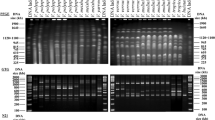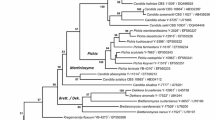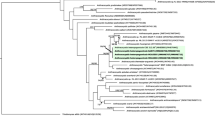Abstract
Four strains of anamorphic yeasts isolated from fruit bodies of mushrooms collected in Japan were found to represent three new species of the genusCandida. These species resembleCandida mesenterica in characteristics commonly employed in the classification of yeasts. On the basis of DNA-DNA reassociation, however, they were clearly distinguished fromC. mesenterica and from one another. Three new species,Candida fungicola, Candida sagamina, andCandida fukazawae, are proposed for these yeasts. The analysis of SSU rDNA sequences suggested that these three species were closely related to each other and toC. mesenterica andC. suecica.
Similar content being viewed by others
Literature cited
Gorin, P. A. J. and Spencer, J. F. T. 1970. Proton magnetic resonance spectroscopy—an aid in identification and chemotaxonomy of yeasts. Adv. Appl. Microbiol.13: 25–89.
Hamamoto, M. and Nakase, T. 1995. Ballistosporous yeasts found on the surface of plant materials collected in New Zealand. 1. Six new species in the genusSporobolomyces. Antonie Leeuwenhoek J. Microbiol.67: 151–171.
Kaneko, T. 1982. Nucleic acids. In: Methods in Chemotaxonomy of Microorganisms (ed. by Komagata, K.), pp. 225–282. Gakkai Shuppan Center. Tokyo. (In Japanese).
Kimura, M. 1980. A simple method for estimation evolutionary rate of base substitutions through comparative studies of nucleotide sequences. J. Mol. Evol.16: 111–120.
Komagata, K. and Nakase, T. 1967. Microbiological studies on frozen foods. V. General properties of yeasts isolated from frozen foods. J. Food. Hyg. Soc. Jpn.8: 53–57. (In Japanese.)
Kurtzman, C. P. and Robnett, C. J. 1998. Identification and phylogeny of ascomycetous yeasts from analysis of nuclear large subunit (26S) ribosomal DNA partial sequences. Antonie Leeuwenhoek J. Microbiol.73: 331–371.
Meyer, S. A., Payne, R. W. and Yarrow, D. 1998.Candida Berkhout. In: The Yeasts, a Taxonomic Study, 4th ed. (ed. by Kurtzman, C. P. and Fell, J. W.), pp. 454–573. Elsevier Sci. Publ. Amsterdam.
Nakase, T. and Suzuki, M. 1985. Taxonomic studies onDebaryomyces hansenii (Zopf) Lodder et Kreger-van Rij and related species. I. Chemotaxonomic investigations. J. Gen. Appl. Microbiol.31: 49–69.
Nakase, T. and Suzuki, M. 1986. The ubiquinone system in strains of species in the ballistospore-forming yeast generaSporidiobolus, Sporobolomyces andBullera. J. Gen. Appl. Microbiol.32: 251–258.
Saitou, N. and Nei, M. 1987. The neighbor-joining method: A new method for reconstructing phylogenetic trees. Mol. Bio. Env.4: 406–425.
Shida, O., Takagi, H., Kadowaki, K. and Komagata, K. 1996. Proposal for two new genera,Brevibacillus gen. nov. andAneurinibacillus gen nov. Int. J. Syst. Bacteriol.46: 939–946.
Sugita, T. and Nakase, T. 1999. Non-universal usage of the leucine CUG codon and the molecular phylogeny of the genusCandida. System. Appl. Microbiol.22: 79–86.
Sugita, T., Nishikawa, A., Ikeda, R. and Shinoda, T. 1999. Identification of medically relevantTrichosporon species based on sequences of internal transcribed spaces regions and construction of a database forTrichosporon identification. J. Clin. Microbiol.37: 1985–1993.
Suzuki, M. and Nakase, T. 1988. The distribution of xylose in the cells of ballistosporous yeasts—Application of high performance liquid chromatography without derivatization to the analysis of xylose in whole cell hydrolysates. J. Gen. Appl. Microbiol.34: 95–103.
Suzuki, M., Nakase, T., Mori, H., Toriumi, H. and Kurtzman, C. P. 1992. Chemotaxonomic study on halophilic/holotolerant yeasts in the matured soy sauce mashes. Bull. JFCC8: 18–27.
van der Walt, J. P. and Yarrow, D. 1984. Methods for the isolation, maintenance, classification and identification of yeasts. In: The Yeasts, a Taxonomic Study, 3rd. ed. (ed. by Kreger-van Rij, N. J. W.), pp. 45–105. Elsevier Sci. Publ. Amsterdam.
Author information
Authors and Affiliations
About this article
Cite this article
Nakase, T., Suzuki, M., Sugita, T. et al. Three new species of anamorphic yeasts phenotypically and phylogenetically related toCandida mesenterica: The description ofCandida fungicola sp. nov.,Candida sagamina sp. nov., andCandida fukazawae sp. nov. isolated from fruit bodies of mushrooms. Mycoscience 40, 465–476 (1999). https://doi.org/10.1007/BF02461023
Accepted:
Issue Date:
DOI: https://doi.org/10.1007/BF02461023




